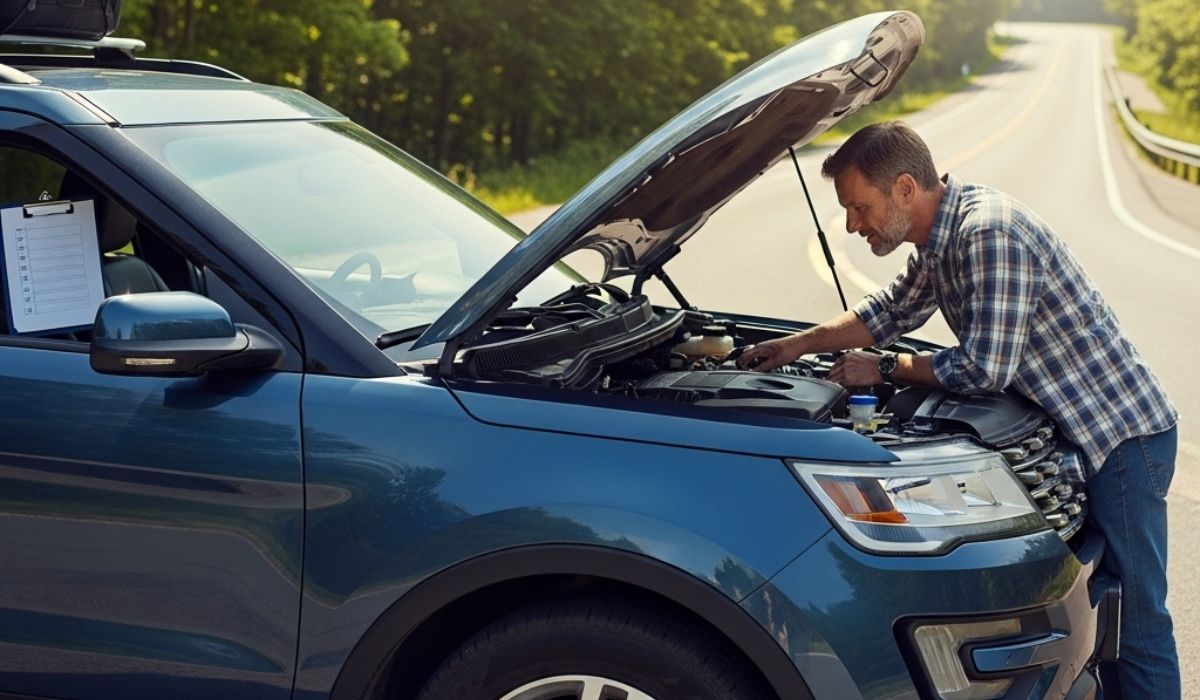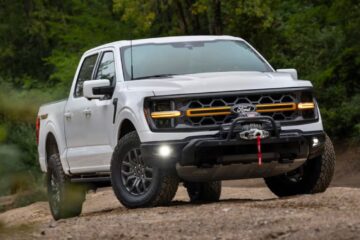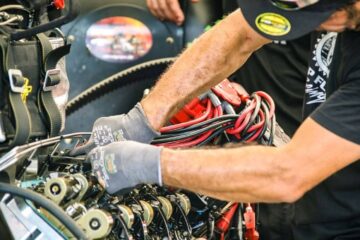The A82 through Glencoe, the Coast Road around the Antrim glens or a dash across the Channel all share one truth: it’s a very long push if your motorcycle fails for a reason you could have spotted in the garage. Most riders dutifully squeeze tyres, glance at pads and top up oil before a trip, yet subtler weak points escape inspection. The guide below walks through ten areas that commonly let us down, offering practical steps you can finish in a single afternoon. Tackle them now and the only van you’ll see on holiday will be the ice-cream one.
Brake-fluid age and boiling-point loss
Brake fluid is hygroscopic, silently absorbing airborne moisture. A 0.1 % rise in water content chops roughly 10 °C from its boiling point, so a fluid that was 260 °C two years ago may boil at 220 °C today. The symptom on a hot, stop-start day is a suddenly spongy lever as vapour pockets compress. First check colour: new DOT 4 is almost clear with a faint straw tint. Anything tea-coloured needs changing. If you tour yearly, replace fluid yearly; the cost is pennies next to fresh discs and a ruined trip.
Flex-points in hydraulic hoses
Hoses flex every time you turn the bars or compress the fork, and they sit in all weather. Turn the steering slowly from lock to lock while watching the lines: any section polishing the headstock or fairing stay will chafe through its outer sheath. Bulging near a ferrule means broken internal braiding. When originals are long in the tooth, many owners retrofit custom motorcycle brake hoses that resist swelling and abrasion, but any hose in sound condition and within its service life is fine—condition matters more than construction.
Steering-head bearings and lockstops
Raise the front wheel on a stand and nudge the bars full left and right. A notch at straight-ahead indicates false brinelling on the bearing races; a faint rumble points to dry grease. Tapered rollers in decent condition can be cleaned and repacked, but pitted ball races are cheap enough to replace. While you’re there, confirm both lockstops are intact—bent or broken stops let the bars hit the tank and crush brake hoses or switchgear wiring.
Oil-cooler plumbing and heat management
Remote oil coolers vibrate on rough roads, and hoses routed too tightly can fret against engine cases. Run a rag along each line: oil leaves a dark smear. Pay extra attention where the hose exits a crimp sleeve. When original lines weep or kink, riders often specify custom oil cooler hoses cut to exact length, but the priority is correct routing: gentle bends, no tension and good clearance from down-pipes.
Wheel-bearing free play
Support each wheel clear of the ground, grasp the tyre at six and twelve o’clock, and rock. Any knock is a dying bearing. Fronts fail first thanks to wheel-change hammering; rears suffer if the chain runs too tight. Drift new bearings in by the outer race only, and chill them in the freezer beforehand so they slide home without violence.
Suspension sag and damping adjusters
Ride height dictates steering geometry and weight distribution. Measure rider sag front and rear with a helper: subtract wheel-free extension from the measurement with you aboard in full gear. Target 30–35 mm at the front and 25–30 mm at the rear. If you need near-maximum preload to reach those numbers, spring rates are too soft and the forks or shock will sit deep in the stroke where damping ports are less effective. While adjusting, wind every clicker fully in and back out to its current position to ensure they haven’t seized.
Charging-system output under load
A fresh battery masks a weak stator for one start, so test with electrical accessories switched on. Clip a multimeter across the battery and hold 5,000 rpm: 13.8–14.4 V is healthy. Anything below 13.5 V means either corroded connectors or a dying regulator-rectifier. Three-pin stator plugs often melt; cut them out and solder joints under staggered heat-shrink. If the regulator lives behind bodywork, add a draught hole so it bathes in airflow.
Tyre valves and age codes
We all check pressures, yet the rubber valve stem can split unnoticed. Flex each valve sideways; cracks at the base demand replacement. Read the four-digit date code on the sidewall (week then year): a “3419” stamp, for example, means the 34th week of 2019. Tyres over five years old harden, square off and lose wet-grip even if they still show tread.
Air-box drains and crankcase breathers
Short commutes let crankcase vapour condense in the air-box. Most boxes have a clear drain pipe clipped at the bottom: pop it free and empty the mayonnaise. Replace opaque rubber with clear tubing so future build-up is visible at a glance. While the lid is off, remove leaves and insects and ensure the filter sits flat on its sealing ridge.
Torque paint on critical fasteners
A dab of contrasting paint across each pair of calliper bolts, pinch bolts and rear-sprocket nuts creates a quick visual check: if paint lines misalign at a fuel stop, something’s backing out. Follow the factory torque chart systematically—under-tight hexes rattle loose, over-tight ones distort alloy corners. Paint pens cost beer money and live happily in the top-box.
Turning a Checklist into a Sunday Workshop Routine
Plan the session. Lay tools in order: tyre gauge, multimeter, torque wrench, grease, split pins, nitrile gloves. Work from the front wheel backward; it reduces the chance of duplication and keeps oily chain lube off brake discs. If the bike lives outside, sling a tarp overhead—raindrops in open brake reservoirs dilute fluid. Music helps; beer can wait.
Use short test rides between stages. For example, bleed the brakes, ride round the block and verify lever feel before moving to bearings or chain slack. Early detection of a wrong calliper seal saves draining fluid twice.
Keeping Evidence: The Maintenance Logbook
Record the date, mileage and work done in a notebook or spreadsheet. Include torque figures, part numbers and spares used; next year you’ll thank your past self when deciding if the rear axle is 88 N m or 105 N m. Photos in a cloud folder prove maintenance to any future buyer and remind you how throttle cables route under the tank.
Packing a Lightweight Contingency Kit
No prep defeats every possibility, so tuck essentials under the seat:
- Two spare fuses of each rating and a mini blade puller.
- Self-vulcanising tape to wrap a split coolant line.
- A credit-card puncture-plug kit with two CO₂ canisters.
- One metre of stainless safety wire for failed exhaust mounts.
- A small Torx or JIS driver, depending on make.
- Cable ties and latex gloves—the universe’s universal fix-alls.
Together they weigh less than a Cornish pasty yet turn a four-hour recovery wait into a 20-minute roadside fix.
Quiet Confidence by Tea-time
Falling for motorcycling rarely begins with reading torque charts, but half a day with a checklist is the unsung hero behind every carefree tour. Complete these ten tasks and you’ll glide onto the Hebridean ferry or slip across the Belgian border with the calm certainty that the trip’s stories will be about sunsets and switchbacks, not sirens and stand-by vans. You’ll arrive by saddle rather than seat-belt, bike humming, memories intact—and a maintenance ritual ready to repeat next year.
Note: This article is provided by “Custom Hoses“ and published by our team. We are not responsible for the accuracy of the information provided.




